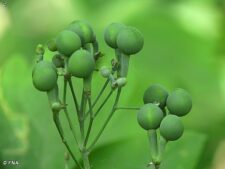
BLUE COHOSH
Caulophyllum thalictroides
BARBERRY FAMILY (Berberidaceae)
 Identification
Identification
- Flowering time - April, May
- Rare in woodlands at NW & FF
- Yellowish-green flower with 6 petal-like sepals
- Compound leaves with sets of 3 leaflets
- Green fruits turning purple at maturity
This native, erect perennial grows from 1 to 3 feet tall. Larger plants have sets of 3 or 4 compound leaves arising in a whorl from a single point on the stem. Each leaf is usually divided into 3 leaflets with 2-3 lobes (A,D). Rising above and separate from the leaves is the flower stalk bearing a panicle of green to yellow-green flowers less than 1/2 inch wide. At the base of the 6 narrow petal-like sepals, the most visible part of the flower, are the small, greenish petals and a circle of yellow anthers (B). The colorful blue fruits are actually seeds with a fleshy deep blue covering. The photo (C) shows green fruits because ours dropped or were eaten before acquiring the color responsible for its common name.
Grows in moist, deciduous woods, flowering in April and May. At Neale Woods a small population exists on an upland terrace along the south side of Rock Creek. It was reported as rare in wooded ravines in Fontenelle Forest as recently as 1980’s, but has not been found there recently.
Dinsmore indicates that the Omahas considered preparations from the root of this plant to be their most effective treatment for fevers.
Other common names include Blueberry Root and Blue Ginseng.
The content of NatureSearch is provided by dedicated volunteer Naturalists of Fontenelle Forest who strive to provide the most accurate information available. Contributors of the images retain their copyrights. The point of contact for this page is: Neal Ratzlaff.



